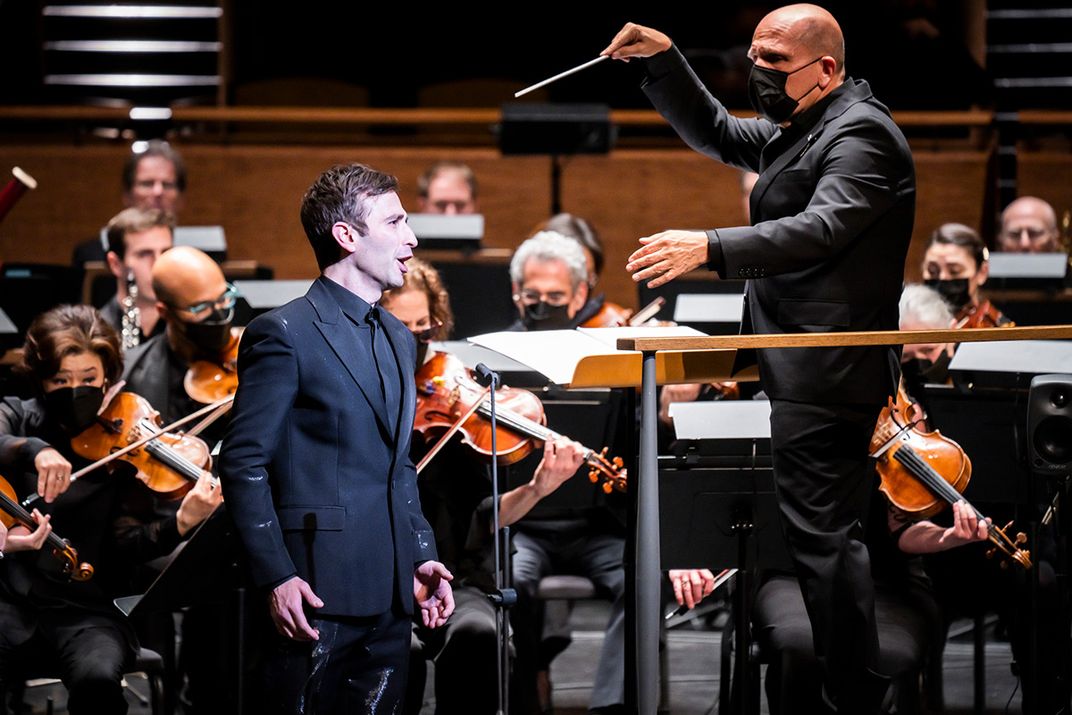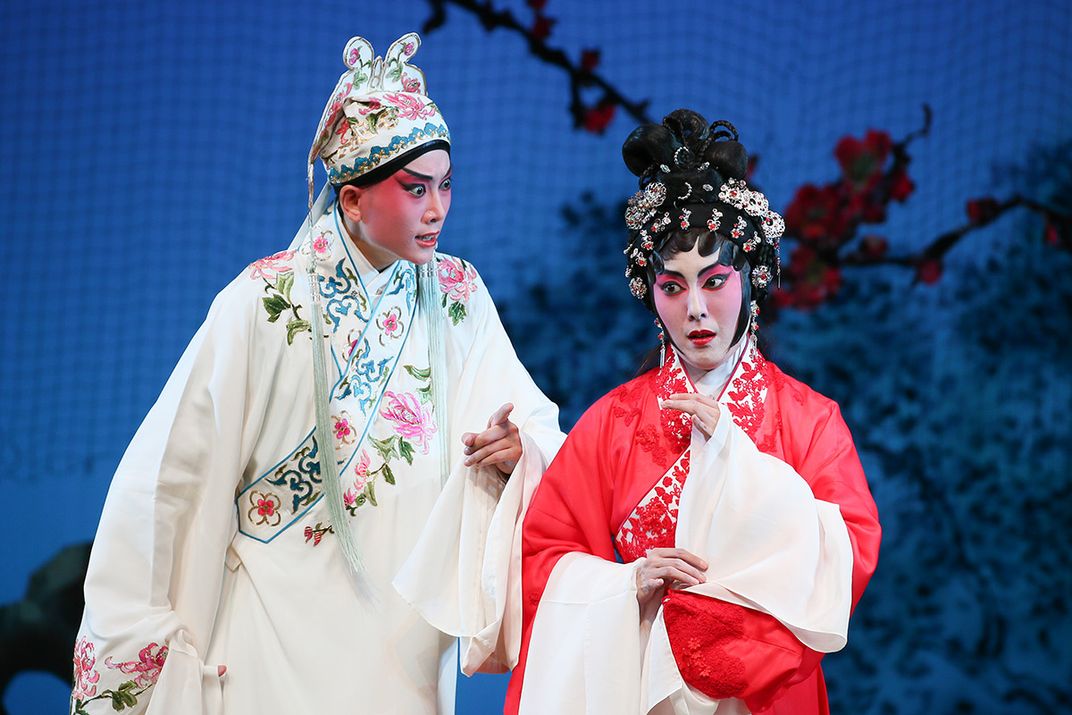SMITHSONIAN CENTER FOR FOLKLIFE & CULTURAL HERITAGE
Warming to Tradition: The Culture of Vocal Exercise
No matter the genre of singing, or where we’re from, our vocal exercises are meaningful.
:focal(600x400:601x401)/https://tf-cmsv2-smithsonianmag-media.s3.amazonaws.com/filer_public/10/4e/104e7897-fe84-4b68-8dd2-7742d56dc40d/ganavya-doraiswamy.jpeg)
Opera singer Anthony Roth Costanzo describes his warm-up routine in seasonal terms: “It’s kind of like starting a car in the winter.”
From a pandemic-era quarantine hotel in Hong Kong, Chinese opera performer Li Pui Yan remarks, “Before an opera, warming up makes me comfortable. It’s just not possible without it.”
South Indian vocalist Ganavya Doraiswamy, speaking from a wooden chapel in the Oregon desert, “Many of the best singers I’ve sung with know, before entering the concert hall—it’s not about warming up your voice. It’s about warming up your spirit.”
All of us who sing tell stories of our learning process. Almost always, this includes how we were taught to prepare our voices. No matter the genre of singing, or where we’re from, our vocal exercises are meaningful. We are taught in the accepted ways our teachers were taught and the experience of their accumulated years. But what singers don’t often get to express to audiences are the personal and cultural meanings our learning traditions, and especially our warm-ups, reveal.
When I began singing at ten years old, I joined the Naples Philharmonic Youth Chorus in Naples, Florida. I looked forward to our weekly rehearsals with palpable anticipation. Nothing mattered until we were packed into our seats, the clock struck 6:30, and our teacher, Ms. Byrd, would order, “Stand up!” She would demonstrate, and our small community would repeat without hesitation: “The big black bear bit the big black bug and the big black bug bled blue blood…”, “Mommy made me mash my M&M’s…”, “I love to sing…”—all in successive keys and always in the same order.
As I grew older and more practiced, the role of vocal exercises in my life became clearer. I’m now a college vocal performance student studying Western opera, and I find exercises more intricate and purposeful. Mainly, my voice lessons consist of finding the right sound and approach to produce a successful aria packed with fast runs of various pitches. Vocal exercises help enormously, especially since I have found that my voice type is a coloratura soprano, the parts of which are written extremely high and with nimble, sweeping ornaments. Without the right preemptive sweeping glissando, I find my high and quick voice swimming in my passaggio, the bridge to the lower and less resonant part of my voice.
Most songs I have under my belt were managed by simply singing their melodies through specific groups of vowels as warm-ups. Visualizing each vowel as having an intentional direction, I feel like I hand the lines of notes inherent meaning and substance beyond words. My warm-ups feel magical to me, as if without them, music could not be made, as if they are sacred.
I wondered if other singers, from other cultures and traditions, felt the same about their learning practices. What could we learn by asking how they warm their voices?

Anthony Roth Costanzo, world-renowned in the field of Western classical music, has performed since the age of eleven. If there is any vocal range for which warm-ups are more necessary, I wouldn’t know of it. Countertenors like Costanzo sing in the highest possible adult male range, sometimes reaching notes in the soprano range. To produce such high, sharp tones, a countertenor needs to learn to sustain his breath through practice and warm-ups.
With a smile, and through Zoom from New York City, Costanzo tells me that at the age of thirteen he learned his voice fell in this highly sought-after range and that he needed guidance.
“I was having trouble reaching a little gap right at the top of my lower chest voice, in the bottom of my higher head voice, and I remember when I warmed up, everything worked much more smoothly, organically.”
When auditioning for music colleges in the early 2000s, the hotels where he stayed were often inconveniently far away. Costanzo made it a point to walk into a hotel within proximity of an audition site and performed his warm-up in an elevator or stairwell. Today, he is regularly featured in productions by the Metropolitan Opera, Berlin Philharmonic, and other companies.
“I do find warm-ups necessary,” he says. “They’ve become an almost superstitious or ritual act, because when you’re stepping on stage in front of thousands of people or on television, you want to make sure you’ll give your best.”
Through years of training, Costanzo learned to associate success with consistent warm-ups.
“When the warm-up has been the thing that has physically allowed you to do it, it takes on a Pavlovian way of preparing you, giving you strength and conviction.” He credits his voice teachers for his regime, saying they would warm him up with specific exercises that addressed the countertenor voice and any difficulties bridging the notes between registers.
When Costanzo performs in a show that features an especially high note, he warms up by singing a half-note higher. When he will perform a piece for coloratura voice, he often chooses to sing syllables through a range of notes.
Jennifer Aylmer, American soprano and vocal pedagogy professor at Carnegie Mellon University, has made vocal exercises a key part of her teaching practice. She explains that the concept of vocal warm-ups is rooted in organically formed traditions. European singers in the 1900s instinctively felt they could not move efficiently from talking to singing.
“Things were sort of elusive, and people taught based on registration—what they heard and instinctively empathetic feelings.”
They translated this “felt” understanding into some of the first recorded vocal warm-ups, where singers developed their control of pitch and tone by producing individual syllables or vowel sounds over a range of notes, as in the coloratura exercises Costanzo employs. The sounds produced were later given the name vocalise, and many vocalise passages are so beautiful that they were notated and turned into art, becoming popular orchestral pieces still treasured today.
Aylmer says that singers and teachers operated under this “feel” method until the invention of the laryngoscope, by Spanish singer and vocal pedagogue Manuel García, in the mid-1800s. Now able to see inside the throat and down to the vocal cords, García and others developed new exercises, which is from where many of the current Western classical warm-ups, like singing the major scale, descend. In the nineteenth and twentieth centuries, these exercises gained further credence through experiments conducted by the scientific and medical communities.
Chinese Opera
“We have a tradition I was taught, a type of breathing called dantian,” says Pui Yan Li, also known as Eliza Li, a third-generation Cantonese opera singer. “It has to do with meditation and how everything points to the bellybutton. We have to breathe from our bellybutton. We practiced that from the very beginning.”
Dantian—translated as “elixir field” or “energy center”—is a common practice in Chinese meditation. A practitioner centers their mind and body in order to strengthen the breath and—ultimately, for singers—the voice.
Li’s parents undertook dantian and vocal warm-ups to a much greater degree than she does today: “My parents would take fabric and tie it like a belt really tightly and go up to the mountain and practice the heptatonic scale”—a seven-note scale common in Xiqu, or traditional Chinese opera. Li tells me that elevation was important. When away from the mountains, her parents would run up to a rooftop to do their exercises.

Dr. Joanna C. Lee, pianist, musicologist, and Chinese cultural consultant, tells me that Xiqu takes a distinct approach to warm-ups because of the voice they traditionally sing in. “Xiqu is much more to the front of the palate than Western opera. In Peking opera, women always sing falsetto. In Western music, the only account of a falsetto is a countertenor.” Thus, vocal warmups in Xiqu are highly specialized, just as they are in Costanzo’s case, and are meant to foster a higher sound, difficult to sustain as singers strain their vocal cords to make them barely touch.
Lee refers to oral histories of Xiqu singers with great seriousness, saying that the physical requirements are more challenging than that of Western classical, as they include demanding fight scenes—martial arts and acrobatics, sometimes with weapons. Popular Chinese operas like The Revenge of Prince Zi Dan (Hamlet), and Hua Mulan feature especially complicated sequences.
“We would have foundation training that takes multiple hours,” Li reports. These physical exercises prepare the entire body, keeping the body aligned and fit for upcoming performances.
Li tells me that her vocal warmups and exercises are “both a tradition and a physical need.” On performance days, it is customary to rest your voice until just before showtime, when you are finally allowed to warm-up. Preparing her for an opera, Li’s mother always tells her, “Don’t talk so much. You have a show tonight.”
Carnatic Music
With a timbre to her speaking voice like butter paired with salty sprinkles in varying cadences, Folkways collaborator, scholar, and composer Ganavya Doraiswamy shares with me her South Indian training experience. She describes the vocal warm-ups she learned while growing up. Akāram vocal warm-ups are sung on the “ah” vowel and are one of the first techniques she was introduced to.
In Carnatic music, akāram exercises consist of fast-moving notes across large ranges, done during Brahma Muhurta, or The Creator’s Hour.
“Brahma Muhurta is about an hour or two before sunrise, and someone somewhere a long time ago believed that that was the best time to practice akāram,” Doraiswamy says. “When I got a little bit older, like twelve, the practice was to drink coffee with some butter in it and then sing, because it did something to your voice.”
Doraiswamy followed these practices because of a desire to make her teachers proud: “I don’t know if it was about the feeling of doing vocal warm-ups as much as it was the feeling of deeply trusting my teachers and being able to show up to class and say without flinching, ‘I did the thing you asked me to do.’” Doraiswamy sees it as a social contract of trust. If you came to class not having done the warm-up, “you know you would’ve broken their trust just a little bit.”
Once, a company Doraiswamy sang with hired a Western-style voice coach to teach her how to take care of her voice. Hearing her sing, the coach claimed Doraiswamy’s vocal cords wouldn’t last two years. Scared by this reaction, she didn’t sing a note for a week. In reality, South Indian singers have sung without injuring themselves for centuries. A warm-up for Western classical vocalists simply would not be used to train the voice of a classical Carnatic singer, although these exercises might seem healthier by Western standards.
Growing up as a serious, professional musician, Doraiswamy was homeschooled and shared a bond with her teachers unlike any other. “At some point, your teacher becomes more powerful than your parents and closer than your best friend,” she says, quietly. Early on, her teachers and the music they taught inspired in her the drive to persist and improve.
The more I listen to Doraiswamy speak, the more I understand that for both of us, the vocal exercises we learned as children were more about knowing ourselves and being accepted into a musical family. Doraiswamy calls them a rite of passage, and I immediately agree. Lately, while examining my training, I’ve come to believe that singers are built upon a succession of notes and the exercises invented to teach them.
For all of us, vocal warmups are a catalyst—social and professional. Through these exercises, we learn our place and whether, eventually, whether we’ll be accepted into the artistic and professional circles we hope to inhabit, whether we’ll make a go of this after all. Along the way, we follow the strict orders of our teachers and help preserve the integrity and tradition of our art form. How we learn to warm up is a cultural badge tailored to the style of music we sing and the sung stories our audiences expect from us.
We all have stories of how we were taught to sing, and some nights we share them with each other. Perhaps these stories are a badge of belonging too.
Zofia Majewski is a writing intern at the Center for Folklife and Cultural Heritage and a student at Carnegie Mellon University with an interdisciplinary major in vocal performance and politics and public policy, with a minor in environmental and sustainability studies.




